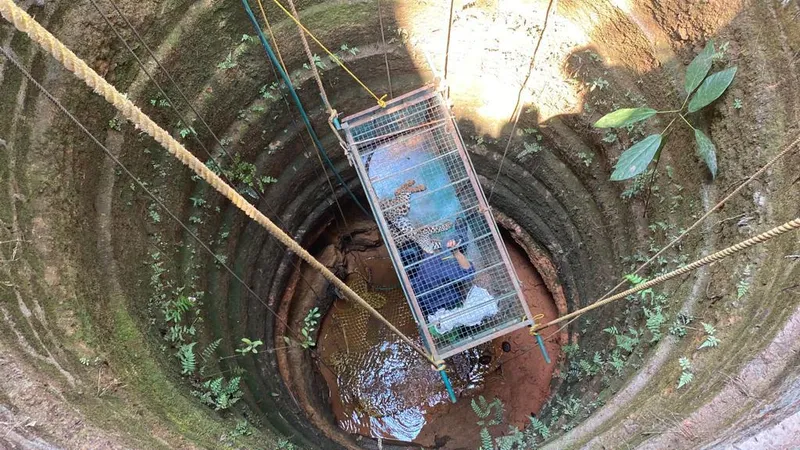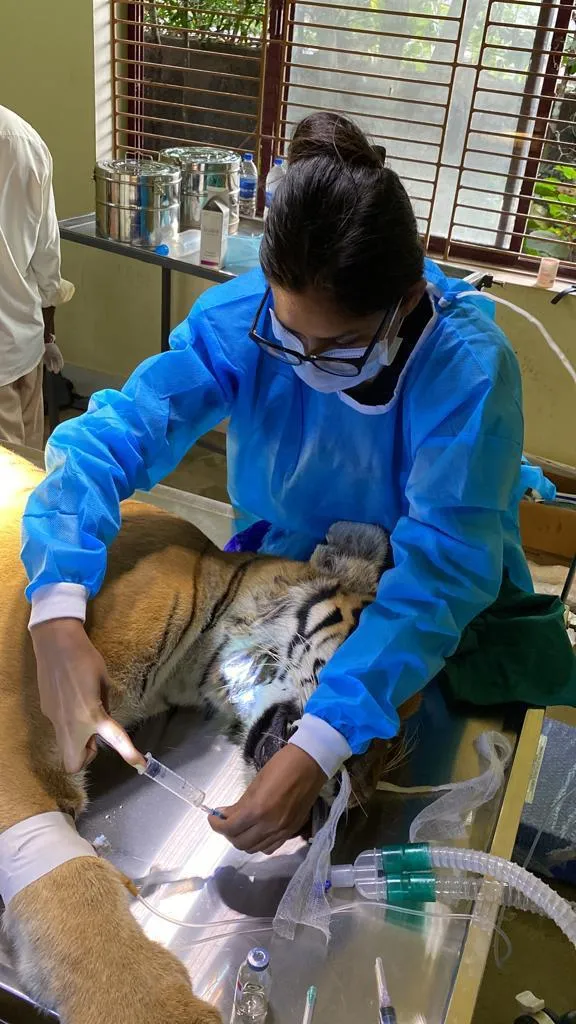This wildlife veterinarian helps Karnataka’s leopards get back home safe
Thirty-two-year-old Meghana Pemmaiah joins the forest department in rescuing big cats trapped in wells and snarls, besides treating the snakes, jackals and birds of the jungle.
The perils of wildlife rescue operations don’t perturb Meghana Pemmaiah as much as the consequences of habitat encroachment do. The 32-year-old wildlife veterinarian wouldn’t think twice before jumping into a well to rescue a leopard, but what unnerves her is the brunt that animals have to bear due to human apathy.
For instance, snakes getting killed at the onset of the monsoon, as they try to cross the highway in search of warmer spaces. Or a herd of elephants losing its way enroute to a waterbody, because of roads being built along their usual path.
“When we don’t understand the consequences of rapid urbanisation cutting into our forests, we don’t understand man-animal conflict holistically,” Pemmaiah tells HerStory.
The wildlife veterinarian shot to fame earlier this year following a heroic rescue operation involving her getting into a cage and descending 20 feet into a well to dart a leopardess that had been trapped inside for two days.
The animal had fallen into the well while wandering into human habitation at this village near Niddodi in Karnataka—a fairly common occurrence in villages that have expanded into forest areas.
The leopardess was hiding inside a cave-like structure on the wall of the well and couldn’t be spotted from outside. So, Pemmaiah had no choice but to get in. On being lowered into the well, she darted at the leopardess at close range, waited until she was sedated, and then dragged her into the cage, before coming back up.

In this rescue operation at a village near Niddodi in Karnataka, Meghana Pemmaiah got into a cage and descended 20 feet into a well to dart a leopardess that had been trapped inside for two days.
For Pemmaiah, this was just another day at work.
“The only thing extraordinary about this operation was that I was closer to the animal than I usually am. We didn’t know anything about the size of the animal or the state she was in; so the only way to rescue her was to get into the well,” she recalls.
In a career spanning seven years, Pemmaiah has treated birds, mongooses, jackals and snakes from the neighbouring forests of Subrahmanya and Kudremukh.
Her first rescue operation happened early last year at a village near Karkala in Karnataka, when she saved a leopard that had been caught in a snare usually set up for wild boars.
Snares can cause fatal damage to an animal, as they are designed to tighten when the animal fidgets or moves, causing injuries to its chest, abdomen, paw, or, in worst-case scenarios, the neck.
“I still consider this operation special because it gave me first-hand experience of human-animal conflict and the urge to spread awareness about it through my work,” she says.
Since then, Pemmaiah—who is based in Mangaluru—has rescued eight leopards from wells and snarls.
Women in wildlife science
A study in 2021 by the College of Veterinary Science in Khanapara, Guwahati, says India requires 72,000 veterinarians to take care of the massive livestock population in the country, but the country has only 43,000.
While more women are now entering the field of veterinary science, they still have some distance to cover, especially in wildlife science.
Pemmiaiah attributes this to the biases that women who aspire to become wildlife veterinarians face at home and within their communities, as the profession is perceived to be too dangerous and uncomfortable for them.
“Sometimes, people walking in with an animal call me ‘nurse’, although they see that I’m dressed in scrubs. And they ask for ‘the doctor’, who they invariably presume must be a man,” she laughs.
“But I’ve gotten used to that,” she says, adding that after the Niddodi operation became viral, more people are recognising her.
Pemmaiah—who has studied veterinary sciences and wildlife medicine at the Veterinary College in Hebbal, Bengaluru—says she has been fortunate to have family and friends who have always rooted for her. It also helped that her father, a superintendent of police, was an ardent supporter of animals and a rescuer himself.
Her husband, also a wildlife veterinarian, guides her through difficult operations.
“There are times when my husband encourages me to go on rescues that he feels I can do better than him. He never hesitates to state this openly to the officials either,” she says.
As per the demands of the job, Pemmaiah is on call 24/7, but she makes it a point to have someone from her team with her when she’s venturing out at odd hours.
While rescue operations seem like acts of daredevilry, safety is paramount, and having a familiar, trusted team makes it easier to finish an operation successfully, she says.
Dealing with human-animal conflict
The dangers of the wild is an occupational hazard that Pemmaiah has learnt to tackle, but what she cannot come to terms with is the lack of sensitivity and awareness among the public and governments about human-animal conflict.
Responding to a query in the Parliament last year, Minister of Environment, Forest and Climate Change, Bhupender Yadav, had said that 7,400 square kilometres of forest land in India have been encroached upon.

When animals’ natural habitats deplete, they enter homes and fields and are harmed or killed.
“When animals’ natural habitats deplete, they enter homes and fields (of human beings) and are killed. Elephants destroy plantations that crop up on their usual route in the forest. Same is the case with monkeys,” she elaborates.
The wildlife veterinarian cites another example, “We recently treated a cobra that had swallowed a plastic can. It was brought in with a lacerated wound on its body. It was probably looking for food."
Pemmaiah is working on educating young people about natural habitats and conservation. She encourages people to call for help instead of killing wild animals that have ventured into their homes and also appeals to them to drive more cautiously on highways that pass through forests.
She thinks governments must consult forest communities and wildlife conservationists while planning infrastructure projects and make sure they avoid routes and patches that the wildlife in that region has been using for years.
“Considering it was us who invaded their habitats first, we must understand that these animals are simply trying to survive, which is a natural instinct. And we must do all that we can to coexist,” she emphasises.
Edited by Swetha Kannan







